The Dynamics of Airplane Flight
Air is a physical substance which has weight. It has molecules which are constantly moving. Air pressure is created by the molecules moving around. Moving air has a force that will lift kites and balloons up and down. Air is a mixture of different gases; oxygen, carbon dioxide and nitrogen. All things that fly need air. Air has power to push and pull on the birds, balloons, kites and planes. In 1640, Evangelista Torricelli discovered that air has weight. When experimenting with measuring mercury, he discovered that air put pressure on the mercury.Francesco Lana used this discovery to begin to plan for an airship in the late 1600s. He drew an airship on paper that used the idea that air has weight. The ship was a hollow sphere which would have the air taken out of it. Once the air was removed, the sphere would have less weight and would be able to float up into the air. Each of four spheres would be attached to a boat-like structure and then the whole machine would float. The actual design was never tried.
Hot air expands and spreads out and it becomes lighter than cool air. When a balloon is full of hot air it rises up because the hot air expands inside the balloon. When the hot air cools and is let out of the balloon the balloon comes back down.
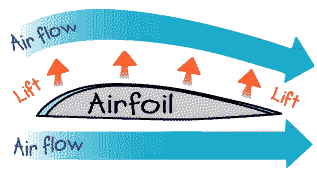
How Wings Lift the Plane
Airplane wings are curved on the top which make air move faster over the top of the wing. The air moves faster over the top of a wing. It moves slower underneath the wing. The slow air pushes up from below while the faster air pushes down from the top. This forces the wing to lift up into the air.
Laws of Motion
Sir Isaac Newton proposed three laws of motion in 1665. These Laws of Motion help to explain how a planes flies.
1. If an object is not moving, it will not start moving by itself. If an object is moving, it will not stop or change direction unless something pushes it.
2. Objects will move farther and faster when they are pushed harder.
3. When an object is pushed in one direction, there is always a resistance of the same size in the opposite direction.
Forces of Flight
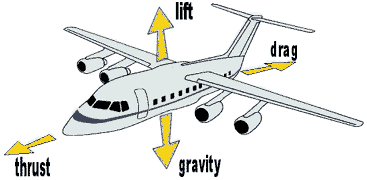
Controlling the Flight of a Plane
How does a plane fly? Let's pretend that our arms are wings. If we place one wing down and one wing up we can use the roll to change the direction of the plane. We are helping to turn the plane by yawing toward one side. If we raise our nose, like a pilot can raise the nose of the plane, we are raising the pitch of the plane. All these dimensions together combine to control the flight of the plane. A pilot of a plane has special controls that can be used to fly the plane. There are levers and buttons that the pilot can push to change the yaw, pitch and roll of the plane.
To roll the plane to the right or left, the ailerons are raised on one wing and lowered on the other. The wing with the lowered aileron rises while the wing with the raised aileron drops.
Pitch is to make a plane descend or climb. The pilot adjusts the elevators on the tail to make a plane descend or climb. Lowering the elevators caused the airplane's nose to drop, sending the plane into a down. Raising the elevators causes the airplane to climb.
Yaw is the turning of a plane. When the rudder is turned to one side, the airplane moves left or right. The airplane's nose is pointed in the same direction as the direction of the rudder. The rudder and the ailerons are used together to make a turn.
How does a Pilot Control the Plane?
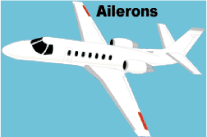
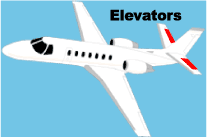
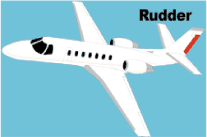
To control a plane a pilot uses several instruments...
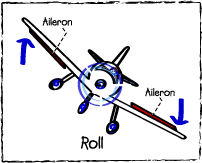 Picture of plane in roll
Picture of plane in rollThe ailerons raise and lower the wings. The pilot controls the roll of the plane by raising one aileron or the other with a control wheel. Turning the control wheel clockwise raises the right aileron and lowers the left aileron, which rolls the aircraft to the right.
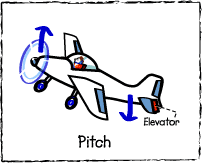
Picture of plane Yaw
The rudder works to control the yaw of the plane. The pilot moves rudder left and right, with left and right pedals. Pressing the right rudder pedal moves the rudder to the right. This yaws the aircraft to the right. Used together, the rudder and the ailerons are used to turn the plane.
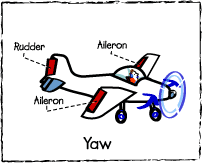
Picture of Plane Pitch
The elevators which are on the tail section are used to control the pitch of the plane. A pilot uses a control wheel to raise and lower the elevators, by moving it forward to back ward. Lowering the elevators makes the plane nose go down and allows the plane to go down. By raising the elevators the pilot can make the plane go up.
The pilot of the plane pushes the top of the rudder pedals to use thebrakes. The brakes are used when the plane is on the ground to slow down the plane and get ready for stopping it. The top of the left rudder controls the left brake and the top of the right pedal controls the right brake.
If you look at these motions you can see that each type of motion helps control the direction and level of the plane when it is flying.
Sound Barrier
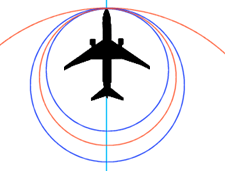


Sound is made up of molecules of air that move. They push together and gather together to form sound waves . Sound waves travel at the speed of about 750 mph at sea level. When a plane travels the speed of sound the air waves gather together and compress the air in front of the plane to keep it from moving forward. This compression causes a shock wave to form in front of the plane.
In order to travel faster than the speed of sound the plane needs to be able to break through the shock wave. When the airplane moves through the waves, it is makes the sound waves spread out and this creates a loud noise or sonic boom. The sonic boom is caused by a sudden change in the air pressure. When the plane travels faster than sound it is traveling at supersonic speed. A plane traveling at the speed of sound is traveling at Mach 1or about 760 MPH. Mach 2 is twice the speed of sound.
Regimes of Flight
Sometimes called speeds of flight, each regime is a different level of flight speed.

General Aviation(100-350 MPH).
Most of the early planes were only able to fly at this speed level. Early engines were not as powerful as they are today. However, this regime is still used today by smaller planes. Examples of this regime are the small crop dusters used by farmers for their fields, two and four seater passenger planes, and seaplanes that can land on water.

Subsonic (350-750 MPH).
This category contains most of the commercial jets that are used today to move passengers and cargo. The speed is just below the speed of sound. Engines today are lighter and more powerful and can travel quickly with large loads of people or goods.
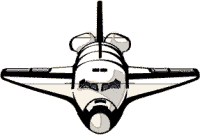 Supersonic (760-3500 MPH - Mach 1 - Mach 5).
Supersonic (760-3500 MPH - Mach 1 - Mach 5).760 MPH is the speed of sound. It is also called MACH 1. These planes can fly up to 5 times the speed of sound. Planes in this regime have specially designed high performance engines. They are also designed with lightweight materials to provide less drag. The Concorde is an example of this regime of flight.

Hypersonic (3500-7000 MPH - Mach 5 to Mach 10).
Rockets travel at speeds 5 to 10 times the speed of sound as they go into orbit. An example of a hypersonic vehicle is the X-15, which is rocket powered. The space shuttle is also an example of this regime. New materials and very powerful engines were developed to handle this rate of speed.


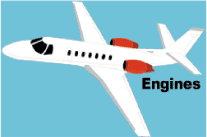
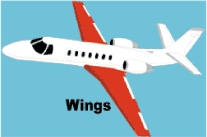
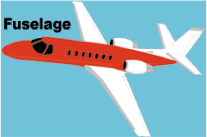
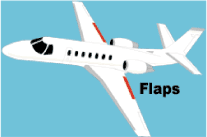
The hinged control surfaces are used to steer and control the airplane. The flaps and ailerons are connected to the backside of the wings. The flaps slide back and down to increase the surface of the wing area. They also tilt down to increase the curve of the wing. The slats move out from the front of the wings to make the wing space larger. This helps to increase the lifting force of the wing at slower speeds like takeoff and landing. The ailerons are hinged on the wings and move downward to push the air down and make the wing tilt up. This moves the plane to the side and helps it turn during flight. After landing, the spoilers are used like air brakes to reduce any remaining lift and slow down the airplane.
The tail at the rear of the plane provides stability. The fin is the vertical part of the tail. The rudder at the back of the plane moves left and right to control the left or right movement of the plane. The elevators are found at the rear of the plane. They can be raised or lowered to change the direction of the plane's nose. The plane will go up or down depending on the direction of that the elevators are moved.
Subscribe to:
Post Comments
(
Atom
)



No comments :
Post a Comment